Everyone wants their content to rank higher on Google. But many still believe that repeating a keyword over and over is enough. The truth is, poor keyword placement can harm your SEO instead of helping it.
If your keywords are stuffed unnaturally, Google may flag your content as spammy. On the other hand, if you don’t use them strategically, you risk missing ranking opportunities. That’s why clear guidelines on keyword placement are essential: where to use it, how often, and how to apply it naturally.
In this guide, we’ll cover the proper techniques of keyword placement, share real examples, and highlight smart SEO practices aligned with Google’s guidelines. And following these practices, you can increase the chance that your content ranks higher and reaches the right audience.
What is a keyword in SEO?
A keyword is a word or phrase people type into Google or other search engines when they’re looking for something like information, products, or services. It’s the main term that connects user intent with your content. In SEO, choosing the right keywords helps your website show up where people can find it.
For example:
- Short-tail keyword: “SEO”
- Long-tail keyword: “how to improve keyword placement in blog content”
- Brand/Product-specific keyword: “Nike Air Max 2025”
What Does Keyword Positioning Mean?
Keyword positioning means where you place your keyword. It’s not enough to just use the keyword; you have to put it in the right spots, like the title, heading, meta description, URL, and at the beginning of your content. This helps Google understand what your page is really about.
“Pages in Google’s top 10 results contain 65% to 85% of the keywords they’re ranking for in their title tag.”—From Backlinko’s Search Engine Ranking Study.
A quick caution: these kinds of statistics show correlation, not causation. In other words, many pages have keywords in the title tag, but that doesn’t guarantee higher rankings.
Best Places to Insert Keywords: How and Where to Do It
The best places to put your keywords are in the title, first paragraph of the intro, headings, meta description, URL, body text, images, internal links, and conclusion. These spots give clear signals to both search engines and your readers.
Google’s latest updates make it clear that keyword stuffing is now penalized. It’s time to be more thoughtful about where and how you place keywords. Avoid forcing exact keywords unnaturally into your content, focus on flow and user experience.
Specific Areas to Place Keywords:
1. Title Tag
John Mueller has stated in the Webmaster Central Office-hours Hangout that a title tag is not a primary ranking factor. But it is still important for ranking. He also made it clear that overstuffing keywords into a title is never a good practice because it hurts user experience.
Google has never said that simply putting a keyword at the very beginning of a title will guarantee rankings. But according to Moz, titles that begin with a keyword often perform better. On the other hand, placing the keyword only at the end may not be as effective.
From my years of hands-on On-Page SEO experience, I can confidently say that when you place the focus keyword naturally toward the beginning of the title, it helps Google’s crawlers understand the topic faster and increases the chances of users clicking on your result.
Tips for better titles:
- You should place the primary keyword near the front of the title if it fits naturally.
- To prevent the title from being cut off in search engine results, it’s best to keep it within 50–60 characters, including keyword placement.
- Avoid stuffing the title with keywords; write a headline that clearly reflects the content’s intent and attracts clicks.
- Make sure it feels helpful and matches what users are searching for, not just what search engines want.
Let’s make it clear with an easy example:
Focus keyword: local SEO service
Bad practice:
“Local SEO Service | Local SEO Service Company & Local SEO Service Experts”
This title is repetitive and stuffed with the same keyword multiple times. It doesn’t tell users what benefit they’ll get or what makes the page different. Google may also see it as spammy, which can hurt rankings.
Good practice:
“One Time SEO Service | Pay Once, Get Real Results!”
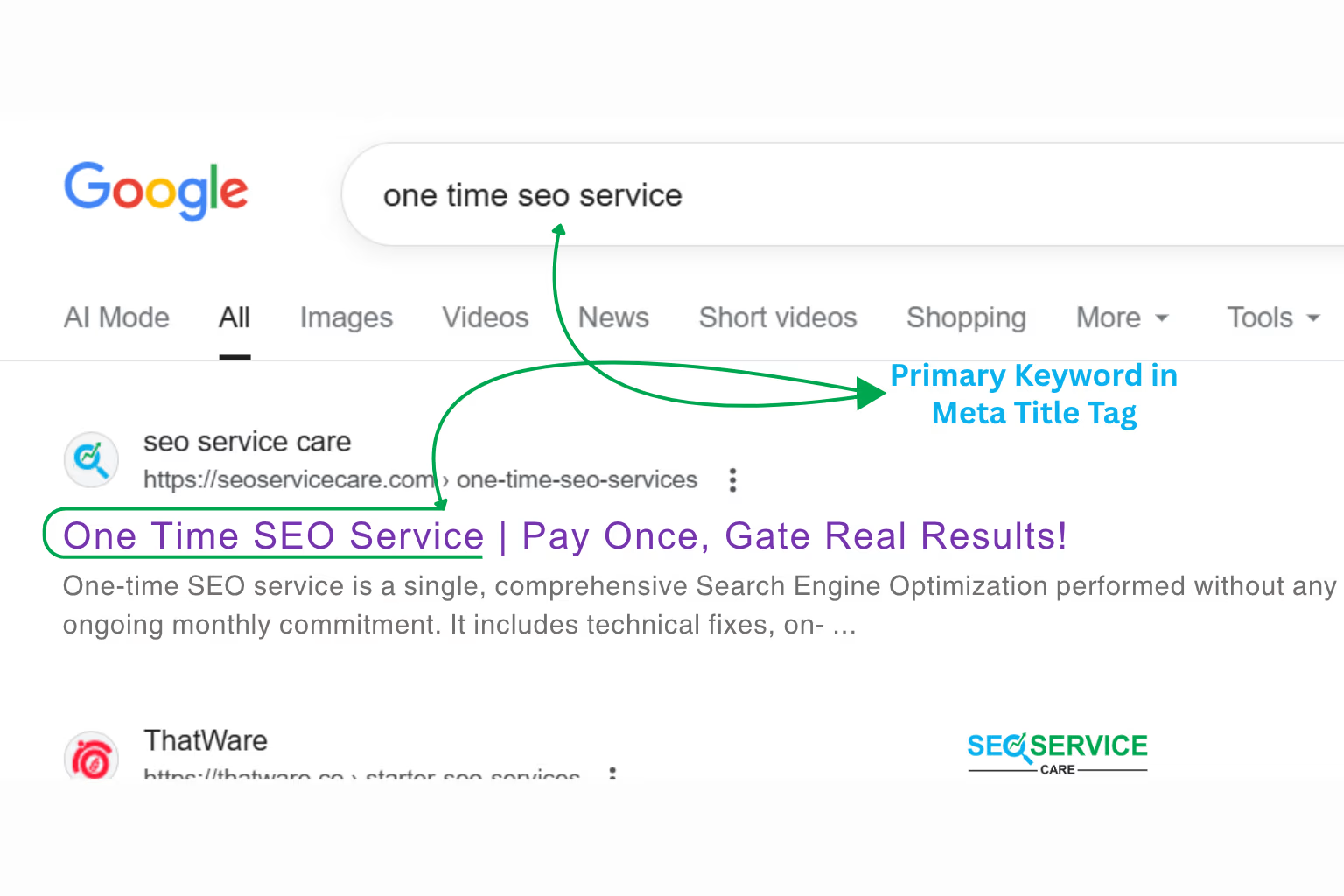
This title uses the keyword once, naturally at the start. It’s clear and benefit-focused, users immediately understand that the service helps their business get seen locally. It’s easy to read, feels trustworthy, and aligns with Google’s preference for user-friendly, descriptive titles.
2. Meta Description
The meta description is the short text shown under your title in Google search results. It’s not a direct ranking factor. But it has a big impact on how many people click or choose to visit your page.
- Use your primary keyword once, preferably near the beginning but not forced.
- Keep it 150–160 characters so it isn’t cut off on google SERP.
- Write in natural, benefit-driven language that encourages clicks.
For example, let’s say you’re writing a meta description for a page on an eCommerce business website. Google has made it clear that filling the description with a list of keywords is a bad practice. A better approach is to write a natural summary that explains what the shop sells, along with useful details like opening hours and location.
Now let’s look at a practical example:
Focus keyword: online shoe store
Bad practice:
“Online Shoe Store, Cheap Shoes, Best Online Shoes, Buy Shoes Online, Shoes for Men, Shoes for Women.”
[Just a list of keywords. No clear value for the user. Looks spammy, low trust.]
Good practice:
“Shop our online shoe store for the latest men’s and women’s styles. Find affordable prices, fast shipping, and quality footwear you’ll love.”
[Keyword used once, naturally. Explains what the shop offers. Highlights benefits (price, shipping, quality). Invites users to click.]
A well-written description with your keyword placed naturally can boost CTR. Higher CTR means more traffic, which supports your SEO.
3. URL Slug
A URL slug is the part of your web address that comes after the domain. For example, in www.example.com/one-time-seo-services, the slug is /one-time-seo-services. URL slugs should be short, descriptive, and include keywords in a user-friendly way.
Real Example:
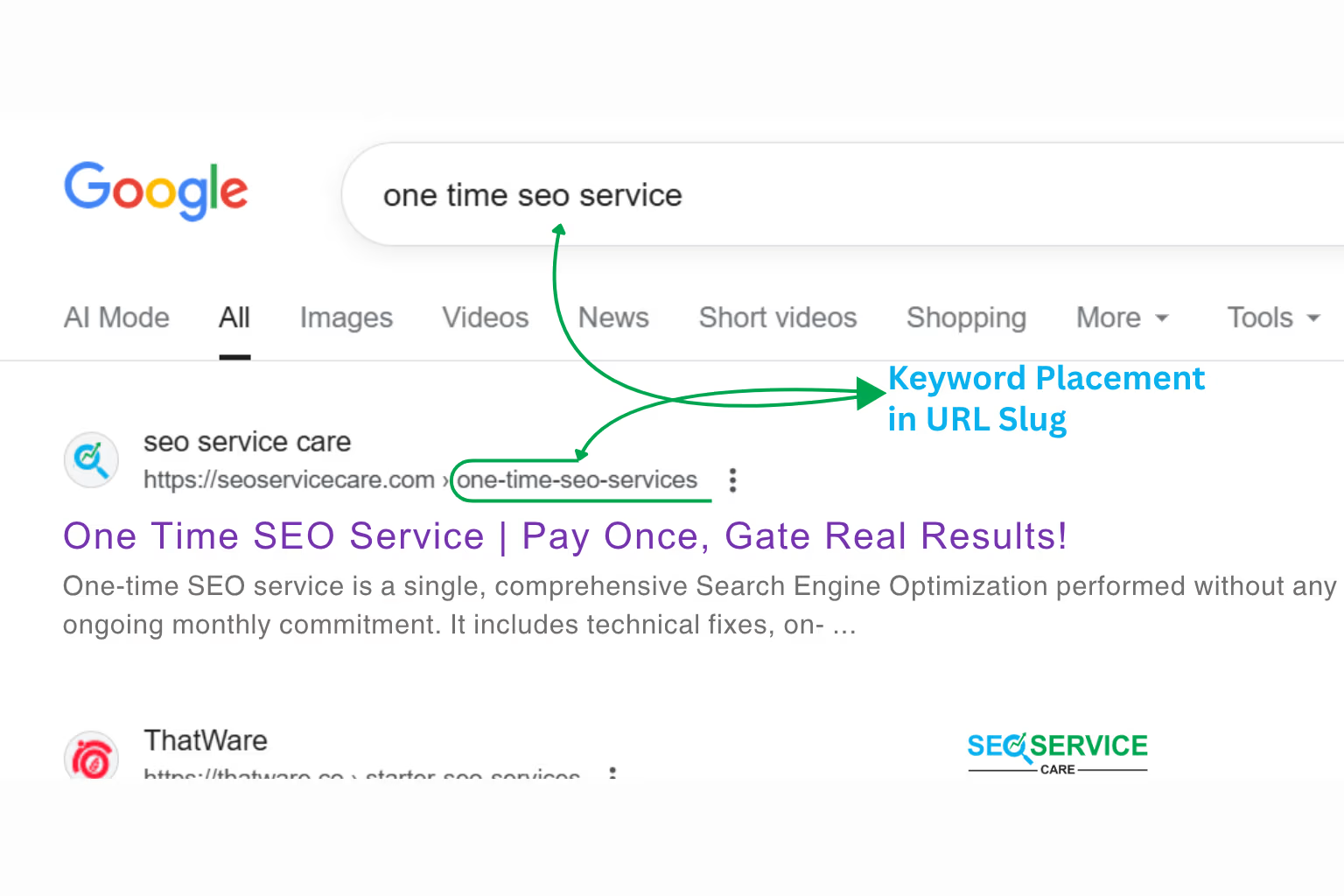
Best Practices for Keyword Placement in URL:
| Recommended (Good Practice) | Don’t Recommended (Bad Practice) |
| Keep the slug short (3–5 words).
Example: /one-time-seo-services |
Keyword stuffing in the slug.
Example: /seo-seo-seo-seo-service |
| Use lowercase letters and hyphens to separate words.
Example: /local-seo-service |
Using random IDs or numbers instead of a keyword.
Example: /product?id=12345 |
| Place the primary keyword once, naturally, near the start.
Example: /seo-guide/advanced-tips |
Adding unnecessary words just to fit the keyword.
Example: /best-local-seo-service-for-small-business-online-free |
| Don’t repeat the keyword; keep it clean and user-friendly.
Example: /keyword-research-tools |
Repeating multiple variations of the same keyword.
Example: /local-seo-service-seo-local-optimization |
Summary:
A single keyword in the URL slug is enough. Keep it natural, short, and user-friendly. Repeated keywords makes Google see it as spam.
Introduction and Conclusion
Introduction (First 100–150 words)
With Google’s latest updates, content has become even more user-focused. In the introduction, briefly highlight the visitor’s problem and show how your page can help solve it. This approach sets the tone, introduces the topic, and gives Google a clear signal about your page’s focus.
Include your primary keyword once within the first few sentences. Make it part of the flow so it reads well. You can also add related terms or variations to help readers understand the topic better.
For example, if the page is about local SEO service:
“Local SEO service is essential for small businesses looking to attract nearby customers. By optimizing your website for local search, you can increase visibility, drive more foot traffic, and grow your business effectively. This guide covers the key strategies and best practices to implement a strong local SEO campaign and get measurable results online.”
The introduction should clearly explain what the content is about, why it matters, and what the reader will gain by continuing. Keep it concise, engaging, and informative.
In Conclusion (50–70 words)
The conclusion is your chance to summarize the main points and leave a lasting impression. Reinforce the primary keyword once, while reminding readers of the benefits or actions they can take.
Example for local SEO service:
“Implementing these local SEO service strategies can boost your business’s visibility and attract more local customers. Following these best practices ensures your website ranks higher in local search results, helping your business grow and reach its target audience effectively.”
Keep the conclusion clear, concise, and focused on key takeaways. Avoid repeating the keyword multiple times; one mention is enough.
Headings (h1, h2, h3…. h6)
Headings (H1, H2, H3, etc.) give your content a clear structure. They guide readers through each section and help search engines understand the Arrangement of information. Proper keyword placement in headings strengthens topical relevance without over-optimization.
Use the primary keyword in the H1 (page title). In H2,H3 to H6 subheadings, include some (but not all) secondary keywords (LSI) and related terms or variations. Keep headings concise, descriptive, and easy to scan.
Avoid forcing the keyword into every heading, quality matters more than repetition.
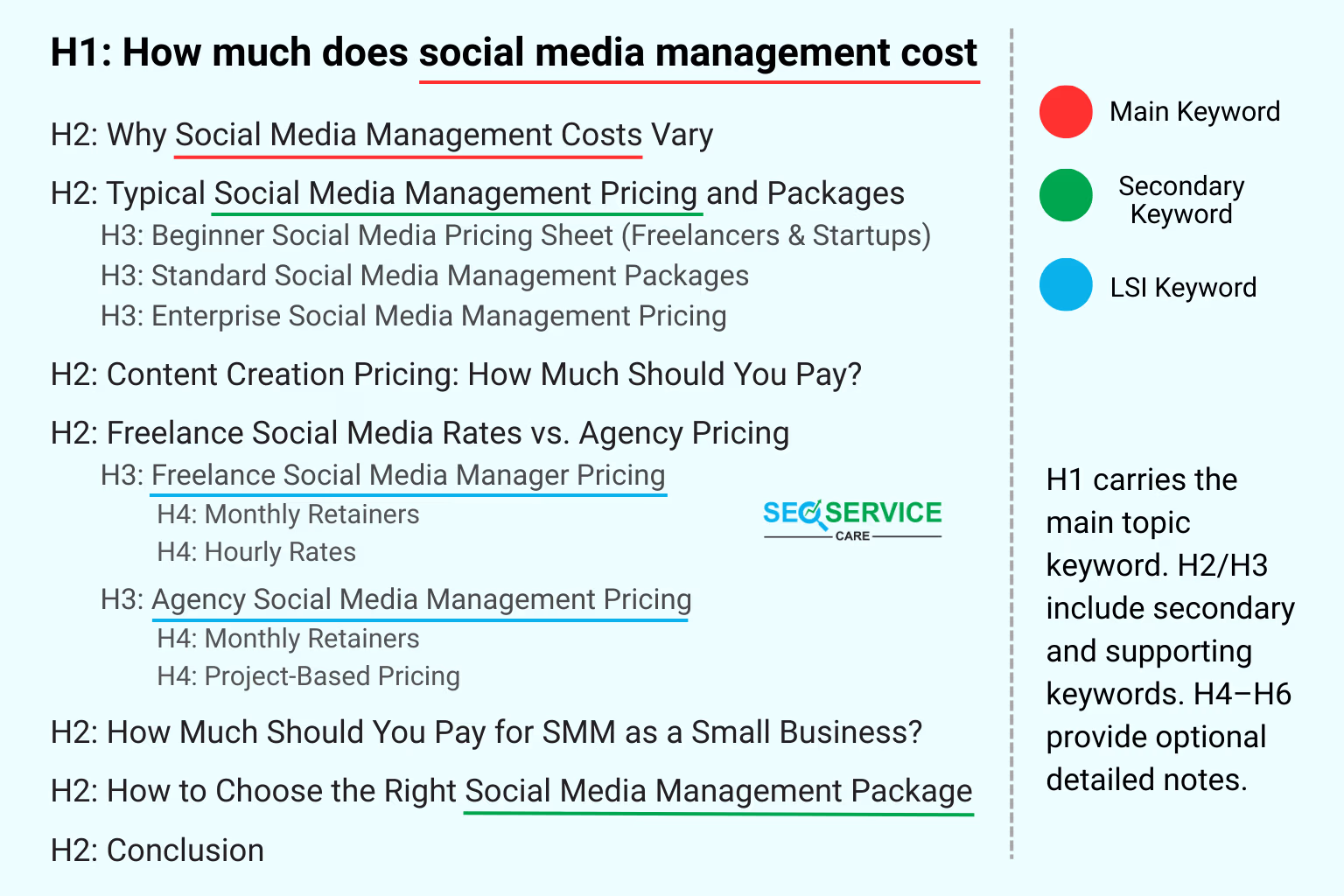
Body Text
The body of your content is where you expand on the topic in detail. This is also the area where keywords carry the most weight, since it makes up the majority of the page.
Use your primary keyword a few times throughout the text, but only where it fits the context. Supporting or secondary keywords should also appear naturally as you explain the subject.
Avoid repeating the same phrase over and over. Instead, use variations, synonyms, and related terms. This creates a smoother reading experience and gives search engines a fuller understanding of your topic.
Always prioritize clarity. Write for your audience first, then fine-tune for search engines.
Anchor Text in Internal Links
Internal links help users navigate your site and signal to search engines which pages are important. The clickable text, called anchor text, plays a key role in this. Proper keyword usage in anchor text can boost relevance and improve SEO.
You should use anchor text that clearly describes the topic of the page you are linking to. Include your primary or secondary keyword only when it fits smoothly into the text. Keep anchor text concise and easy to read; avoid long or awkward phrases.
Link only to relevant pages, do not insert links just to add keywords.
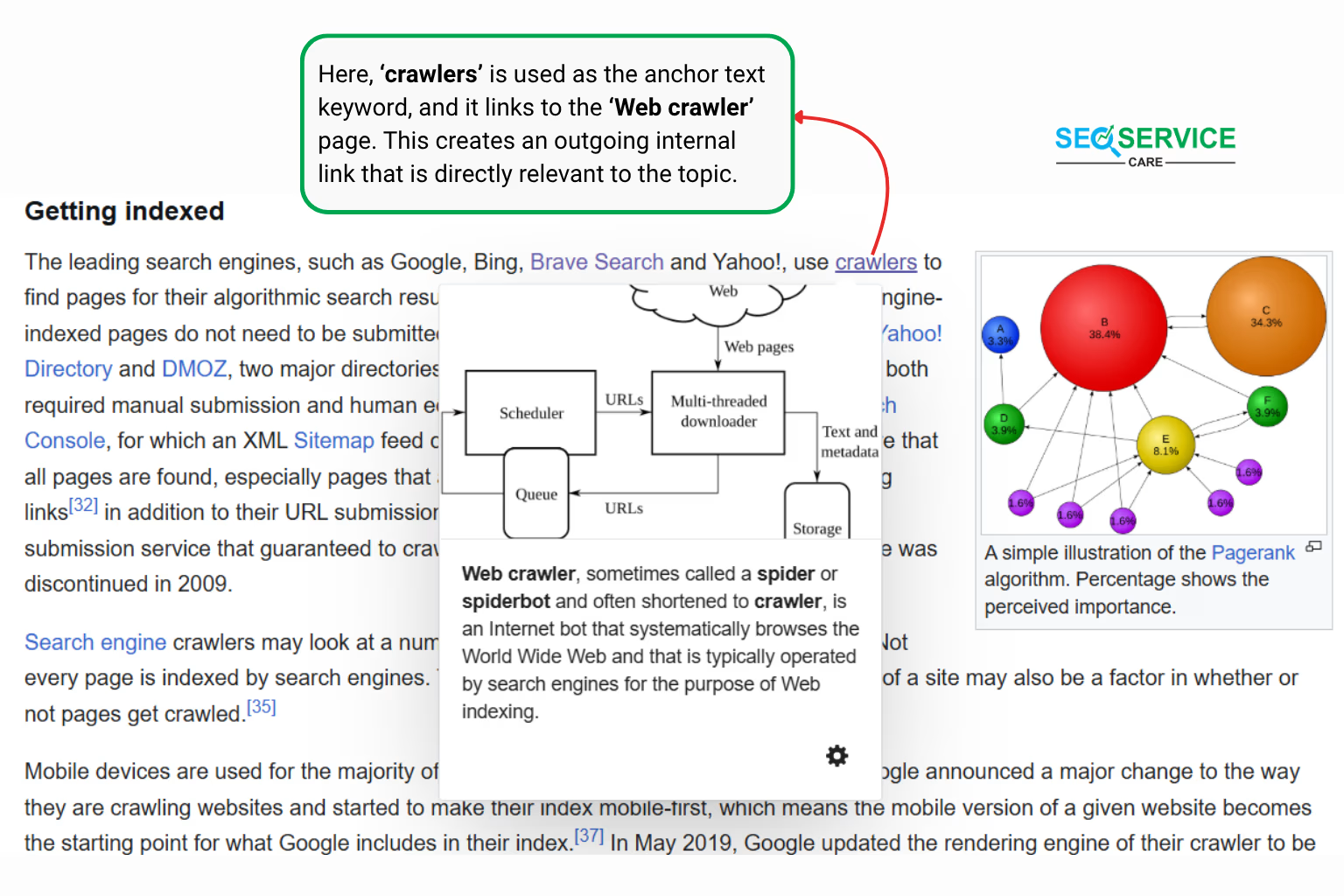
Related Article: How Many Internal Links Per Page SEO (Complete Guide 2025)
Image File Names & Alt Text
Images are an important part of content. They make your page engaging and provide additional SEO signals when optimized correctly. Both the file name and alt text help search engines understand what the image is about.
For image file names, use short and descriptive file names that clearly explain the image content. You may include your primary or secondary keyword, but always make sure the keyword is relevant to the image. This is the most important factor when writing an image file name.
Then image alt text is one of the important things of image seo. The keyword must match the image’s context. Google values relevance more than frequency. Aim for 5–15 words, long sentences or repeating keywords can harm readability and SEO.
You can provide an image with a short prompt to ChatGPT. And it will generate a suggested alt text that you can review and tweak if necessary.
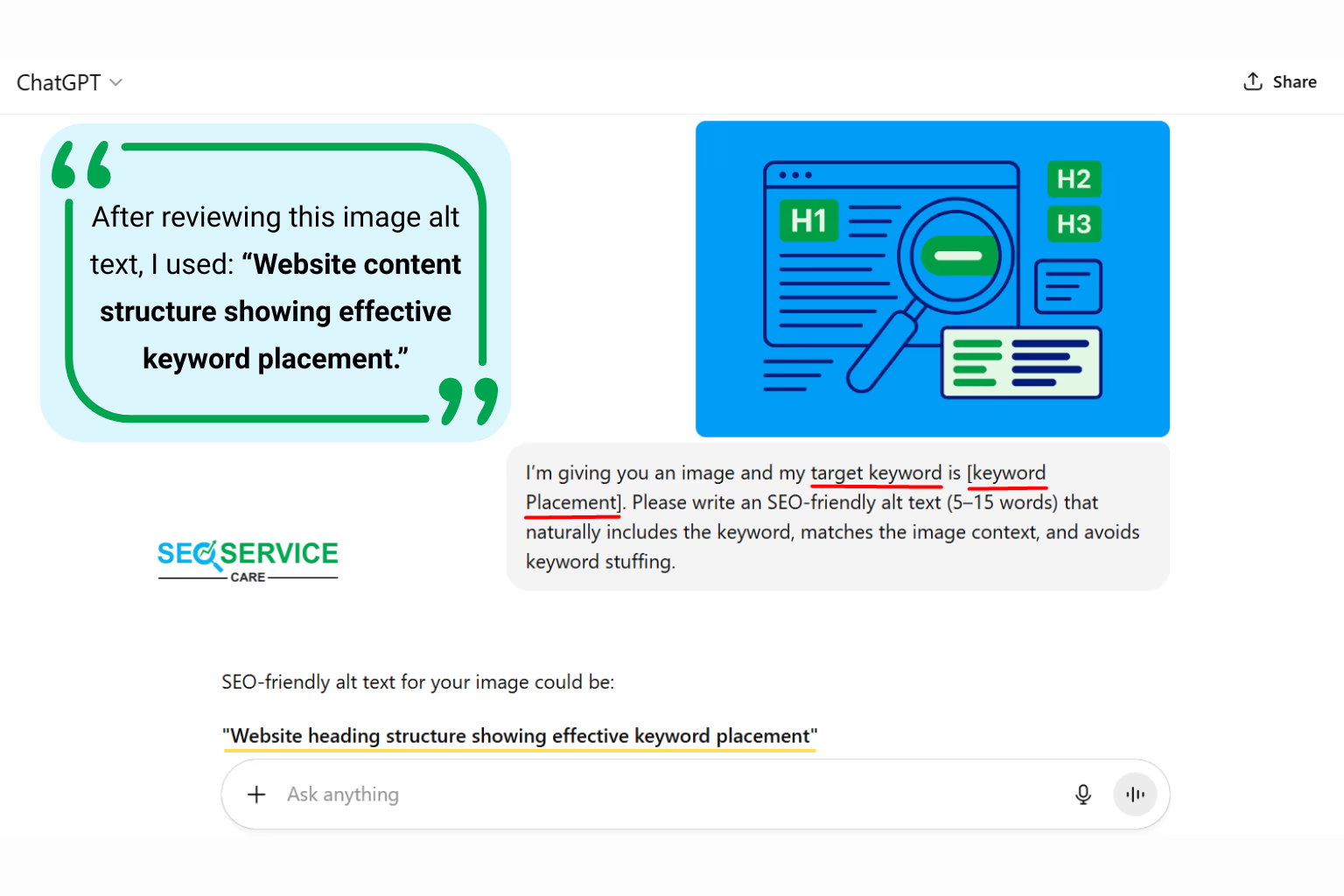
Prompt: I’m giving you an image and my target keyword is [insert keyword]. Please write an SEO-friendly alt text (5–15 words) that naturally includes the keyword, matches the image context, and avoids keyword stuffing.
Keyword Density: Myth vs. Reality
For years, many believed that maintaining a specific keyword density (like 2% or 3%) was essential for ranking. In reality, Google has never provided a fixed percentage for keyword use.
John Mueller (Google Search Advocate) has repeatedly made it clear:
“Keyword density does not matter, but being explicit does matter and contrary to the old SEO myth, story, joke, commentary, you don’t need to mention all possible variations either. Think about what users might be searching for and use the same terminology. It makes it easier to find your pages, and it makes it easier for users to recognize that they have found what they want.” (Search Engine Roundtable)
Instead of chasing a percentage, focus on writing content that flows naturally and delivers real value to readers. A simple guideline: if your keyword appears once in every 100–150 words without sounding forced, you’re on the safe side.
Pro Tips: Forget the density myth. Prioritize meaningful, reader-friendly writing where keywords appear in context not just to hit a number. Remember, Google now uses AI and NLP to understand content. Smart SEO means using keywords in context, not forcing them.
Final Thoughts: Balancing SEO and Readability
At the end of the day, keyword placement isn’t about chasing numbers, it’s about clarity and context. Because Google now prioritizes user-friendly content. So, write for people first, then optimize for search engines.
If you focus too much on keywords, your writing can feel forced and spammy. If you ignore them completely, your content may not rank.
The real key is balance. Use keywords where they naturally fit: in titles, headings, introductions, and important sections of your content. Beyond that, let your writing flow naturally and trust that Google’s algorithms can pick up on context through synonyms, related terms, and overall topic relevance.
Now it’s your turn: apply these keyword placement techniques in your next article and see how better structure, clarity, and relevance improve both user experience and search visibility.
If you have any other questions, feel free to contact our SEO experts today for a free consultation.
Or, call us directly for immediate assistance.



